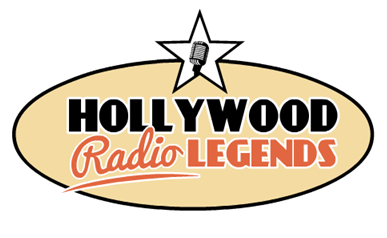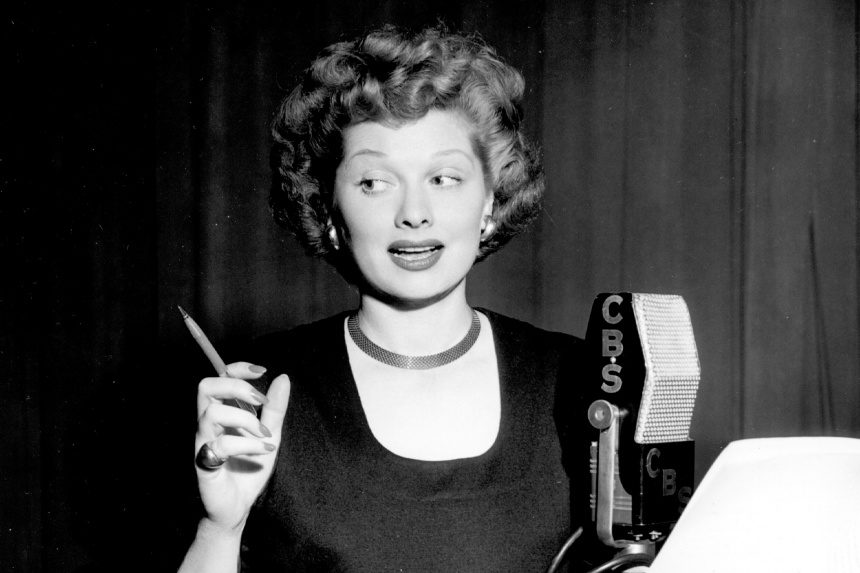
As Lucy Ricardo, she brought a tomboy’s enthusiasm and a scatterbrained quality to the long-running I Love Lucy (1951-61) television program. She was the wacky wife making life difficult for a loving but perpetually irritated husband. It’s ironic when you consider the early stages of her acting career: With ambitions to become an actress, Lucille Ball entered a dramatic school in New York City in 1926, but while her classmate Bette Davis received the raves, Ball was sent home on the grounds that she was “too shy.” This classification might have been the Dumbo feather that motivated her into appearing in comedies such as Look Who’s Laughing (1941), The Fuller Brush Girl (1950) and as a sidekick to the Marx Brothers in Room Service (1938).
When she was 12, Ball was encouraged into show business by her grandfather, who enjoined her to entertain his cohorts at the Shriners club. After adopting the stage name Diane Belmont and being fired from several chorus jobs, she retreated to her home in Celoron, New York, where she spent two years battling the crippling effects of rheumatoid arthritis, a handicap she kept secret for most of her life. Returning to New York in the early 1930s, Ball returned to working as a model for Hattie Carnegie while also earning money as a Chesterfield cigarette girl. She soon embarked on a Hollywood career, which at first consisted mostly of walk-ons and bit roles before she was turned into a glamorous Goldwyn showgirl in the Eddie Cantor musical, Roman Scandals (1933). Under contract by Columbia, the then-blonde, statuesque actress continued to appear in small roles — most notably as a foil for the Three Stooges in one of their earliest film shorts — before her option was dropped. RKO hired Ball at the urging of producer Pandro S. Berman, who featured her in supporting roles in the Fred Astaire-Ginger Rogers films Roberta (1935), Top Hat (1935), and Follow the Fleet (1936).
Working her way up Hollywood’s ladder, in the summer of 1948 she accepted the role of Liz Cooper, a zany housewife who found herself facing comical situations, in the radio comedy My Favorite Husband. In the radio series, Lucille Ball’s husband George Cooper was played by veteran actor Richard Denning. In 1950, CBS came knocking with the offer to adapt the popular radio program to television. Unable to convince network brass to let her real-life husband Desi Arnaz play her husband on the television series, she was given creative control to create her own situation comedy series, I Love Lucy. Here, she and Arnaz pioneered the three-camera technique now considered the standard in filming television sitcoms. She also became the first woman to own a television studio, when she headed Desilu Productions.
In 1952, her real-life pregnancy was written into the show, although the network objected to the use of the word “pregnant” and instead opted for the word “expectant.” All of her pregnancy episodes were reviewed by a minister, a priest, and a rabbi to make sure nothing on screen would be considered offensive. When Lucille Ball gave birth on television to her first child, all of America was glued to the screen. On that evening, I Love Lucy had larger ratings than the coronation of Queen Elizabeth II and President Eisenhower’s inauguration.
Paid $50 a week for her role as a supporting actress in Top Hat (1935), Ball now graduated to $3,500 an episode for I Love Lucy, along with part ownership of the mega series. Her next-door neighbor, Jack Benny, often referred to her as “Chesterfield,” after learning that the comedienne was once a spokesmodel for the cigarette brand. But it wasn’t Benny who taught her how to perform on camera. Lucille Ball credited Buster Keaton as her mentor, remarking: “He taught me most of what I know about timing, how to fall and how to handle props and animals.”
Behind the camera, the relationship between Ball and Arnaz was all business until they retired to their homestead between seasons. When they were first married in 1940, Desi Arnaz had to give his wife-to-be a ring from a drugstore because all of the jewelry stores were closed. She wore it for the rest of their marriage. In 1960, Ball and Arnaz shocked fans when they divorced just two months after filming the final episode of The Lucy-Desi Comedy Hour, though the two remained close friends until his death in 1986, even though both would go on to remarry. Both made it clear in multiple interviews that each was the love of the other’s life.
Lucille Ball attempted to revive her television career — twice — with The Lucy Show (1962-1968) and Here’s Lucy (1968-1974). Neither program found the same success as I Love Lucy, and after the latter program concluded, Ball was quoted as saying, “It was a hell of a jolt to find myself unemployed with nothing to do after more than 25 years of steady work.” She starred in a number of television specials, made numerous guest appearances on other programs, and appeared on several awards shows. Her appearance at the 1989 Academy Awards, standing alongside her longtime close friend Bob Hope, resulted in a standing ovation. Her health, however, was taking a steep decline. Just a year prior she was admitted to Cedars-Sinai Hospital after suffering a stroke. Weeks after the Academy Awards ceremony, Ball was hospitalized after suffering from an aortal aneurysm. She underwent surgery, and the following day her aorta ruptured. She passed away April 26, 1989.
Her success can be measured in many forms. In 1968, Lucille Ball was reported to be the richest woman in television, having earned an estimated $30 million. She remains the only Hollywood celebrity to grace the front of two postage stamps: a 34-cent stamp, issued in 2001 and a 44-cent stamp, issued in 2009.
Carl Amari is the host of the nationally-syndicated nostalgia radio series Hollywood 360. Amari is also the curator of The Classic Radio Club.
Featured image: Lucille Ball (Carl Amari private collection)
Parts of this profile originally appeared in an article by the author on the website Do You Remember?
Become a Saturday Evening Post member and enjoy unlimited access. Subscribe now

 The Saturday Evening Post and Carl Amari want to give you a FREE digital download of the classic radio comedy series My Favorite Husband starring Lucille Ball. Visit
The Saturday Evening Post and Carl Amari want to give you a FREE digital download of the classic radio comedy series My Favorite Husband starring Lucille Ball. Visit 


Comments
Just to set the record straight – Lucille Ball did give a weekly television series one last try with the “Life with Lucy” series on ABC in 1986. She had just come off rave reviews the year before for an excellent dramatic portrayal of a homeless woman living on the New York streets in the TV movie “Stone Pillow”. So she went to the sitcom well one last time with her old pal Gale Gordon by her side. Unfortunately, the ratings were bad and ABC cancelled the show after two months and 8 episodes aired. Reportedly, poor Lucille Ball was devastated by this seeming rejection and rare failure after all her sitcom success. My own take is that sitcom tastes had just evolved and moved on and, unfortunately, watching a much frailer woman in her 70s teetering atop a high ladder was less gut-bustingly funny and more fearful for the poor woman’s safety and judgement. The magic just wasn’t there anymore.
I grew up watching I Love Lucy and laughing so hard my dad told me once I wore out a sofa rocking about and laughing so hard while watching the show EVERY week!!
I’ve been fascinated by articles and radio segments about Lucille Ball. She was certainly a visionary, if not genius, in the development of television entertainment. Despite her goofy personas, in real-life she comes across as a woman who had the hutzpah to make decisions and take risks to succeed in her field. I agree with the comment made by Bob McGowan that in order to be a “Lucy fan” one would need to be acquanted with all of her work, not just I Love Lucy.
With the 70th anniversary of ‘I Love Lucy’ coming next month, this feature takes a timely look at the ultimate female entertainer (not to mention businesswoman) of the 20th century!! She did NOT have an easy time of it at all, with many ups and downs discussed here.
She struggled to find her ‘niche’ which really took hold with the successful ‘My Favorite Husband’ radio show. Television was the next logical step, and unprecedented success; all with hard work. I Love Lucy was 6 seasons (1951-’57) with the 13 ‘encore’ hour-long ‘Lucy-Desi Comedy Hour’ shows from ’57-’60. They kept the show ‘alive’ on an intermittent basis as Lucy and Desi were immersed in running their TV empire, creating more classic dramas and comedies.
Something I noticed on my own was how cleverly Lucy transitioned from one show to the next. For example, the move to the country house in the final half-hour ’57 ‘I Love Lucy’ episodes, transitioned it into the hour-long episodes. With more scenes in those of Lucy and Ethel and less of Lucy and Ricky, that helped transition things for ‘The Lucy Show’ starting in 1962.
The first season opening credits cleverly used a cartoon of Lucy and Viv scrolling the credits making it VERY clear upfront Desi Arnaz and the I Love Lucy writers team were 100% part of this show too, in no uncertain terms. Later the kaleidoscope opening (a favorite) took its place when she no longer had to establish the show.
There were really 2 Lucy shows within ‘The Lucy Show’ series. It went from black & white to color, Viv left as a regular at mid-decade, Gale Gordon was brought in as Mr. Mooney whom Lucy worked for as his secretary. Mary Jane Croft helped fill the gap left by Viv. This transitioned into ‘Here’s Lucy’ where she tweaked the new series to feature Lucie & Desi Jr., but she had the ground work and dynamics established.
One of the biggest treats of this series was Lucie Arnaz! She was the perfect co-star for Lucy. The fact she was her real life daughter didn’t change that (fact) at all. I love Lucie too–to this day!
Per paragraph 7 Carl, ‘The Lucy Show’ and ‘Here’s Lucy’ were more than “attempts” at reviving her TV career. These were extremely successful Top 10 shows for almost all of each 6 year run. In her final season of ’73-’74 it slipped downward, but was still in the top 25.
Lucy Carmichael and Lucy Carter were the next evolutions of Lucy Ricardo. The shows got a lot of acclaim when they were new. Maybe not like ‘I Love Lucy’. That show was impossible to top, and it has elbowed her later series out of the public consciousness almost entirely over the past 5 decades, which is wrong and sad.
I run into people claiming to be big Lucy fans, but have never seen her later shows, and don’t seem interested. They only want to see the original shows over and over, not accepting the later shows. Are they really Lucy fans? I say no, they’re not.
The Beatles (who were big fans of Lucy by the way) had a similar situation with many so-called ‘fans’ only accepting the music/albums they created AS the Beatles, and not their solo post-Beatles work. Maybe a little, but not really. The excuse I hear for that is “it’s not the Beatles.”
I don’t argue with people that say that, but will say there was good-great and so-so to poor in both categories. This is also true for the Eagles during their original years as a group, and solo in the 80’s. Things are never all one way. But this article is about Lucille Ball, and end by saying we clearly see how high she flies to this day.